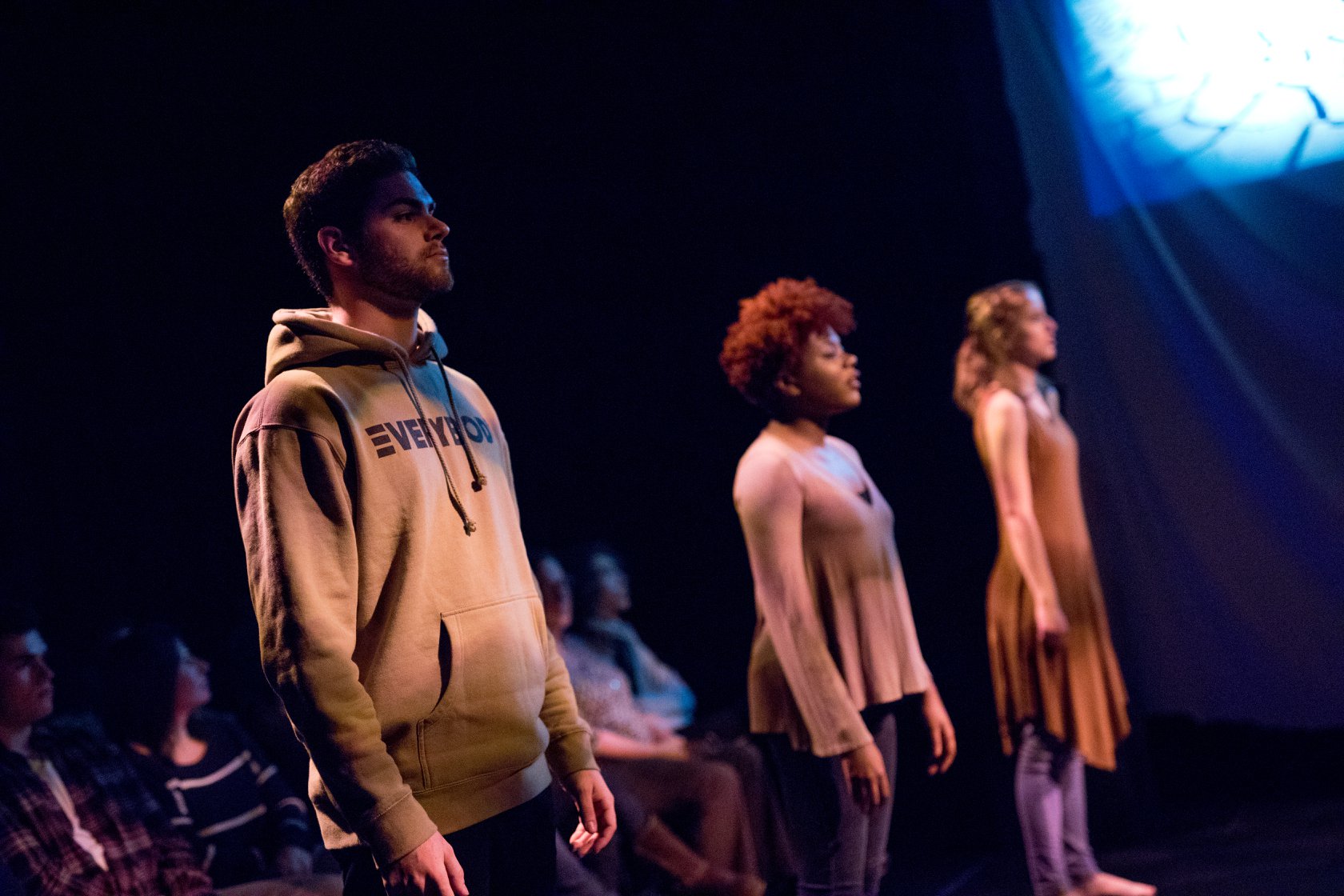
Benchmarking
The Working Group aimed to understand the DEI work being done at other universities, first in regards to identifying if there was a Diversity ILG present at that university, along with the scaffolding or developmental work connected to it, as well as examining the implementation, assessment, and accountability for that ILG and other DEI work associated with the strategic plans underway at those respective universities.
Scope
Institutions
Four universities with strong curricular and (co)-curricular focus and programming, as well as thirteen peer institutions judged to have substantial Diversity and DEI values were identified for the purposes of this benchmarking process.
Main Objective
How is DEI work functioning on these campuses at the Institutional Learning Goal level (curricular and (co)-curricular)? How can we infuse this work into our campus broadly and to do so in a coordinated and intentional way?
Rubric
In order to assess each institution, a rubric was developed through a series of questions to guide and help gathering data and information in a systematic and consistent manner from all seventeen university websites.
Findings: In a Nutshell
Implementation Goals
Once we had gathered information from selected universities, we reviewed the collected data, looking to distill the information into key takeaways that would contribute to the successful implementation of our own Diversity ILG. While there is certainly plenty of crossover between these areas, we identified the following five Implementation Goals to help direct subsequent Diversity ILG work.
Goal 1: Clear Scaffolding of Diversity
As a whole, we found fewer examples of scaffolding in the creation and implementation of developing stronger diversity practices than we expected. We suspect this may be in part because other institutions are similarly struggling with creating effective models and measures for implementing this type of work. The decision to pursue a scaffolded model was primarily informed by the Vocation ILG Implementation Team.
Goal 2: Connections between the Curricular & (Co)-curricular
In order to develop, sustain, and maintain a community dedicated to the Diversity ILG, the team recognizes that curricular and (co)-curricular opportunities must work together, building upon and complementing each other. More importantly, such offerings must be provided to the campus as a whole—to students, faculty, and staff.
Goal 3: Strong Accountability Measures
Universities with strong accountability measures showed the most promising growth and improvement toward a sustained campus-wide commitment to diversity, social justice, equity, and inclusion. All universities with such measures included DEI work as central to their strategic plan. With this in mind, institutions with excellent accountability measures also provided multi-year plans.
Goal 4: Diversity as an Action Plan, Not as Another Layer of Administration
If the entire university is to be responsible for increasing our capacity to perform diversity work, accountability measures need to be incorporated broadly and widely across the university, not merely at the top levels of Administration. In conjunction with Goals 3 & 5, the development of a successful Diversity ILG requires ownership and engagement of the work being performed.
Goal 5: Assessment that Helps Foreground Change & Growth
The role of assessment builds upon the work of accountability, looking to measure and make visible the ongoing work being accomplished, and/or highlight areas where intended actions and goals are not being realized. Strong assessment measures can help redirect attention to deficiencies that become visible or that have not been realized, and can be helpful in tracking progress and change over time.
As a whole, we found fewer examples of scaffolding in the creation and implementation of developing stronger diversity practices than we expected. We suspect that this may be in part because other institutions are similarly struggling with creating effective models and measures for implementing this type of work. As well, the initial decision by the 2019 Diversity and Social Justice Curriculum Fellows to pursue a scaffolded model for the Diversity ILG when creating the Diversity ILG Learning Continuum was informed by Steve Wilhoit’s work with the Vocation ILG Implementation Team, where the focus was on creating a developmental, scaffolded model for Vocation that could be mapped across a student’s time at UD. Steve’s comments regarding scaffolding highlighted the value that comes with making developmental models visible, and his insights allowed us to resolve several of the questions we were struggling to answer.
Of the examples we did find, two are worth noting. The first is the University of San Diego’s Community Engagement Rubric, where Cultural Competency is one of the four areas students’ developmental capacity is assessed:
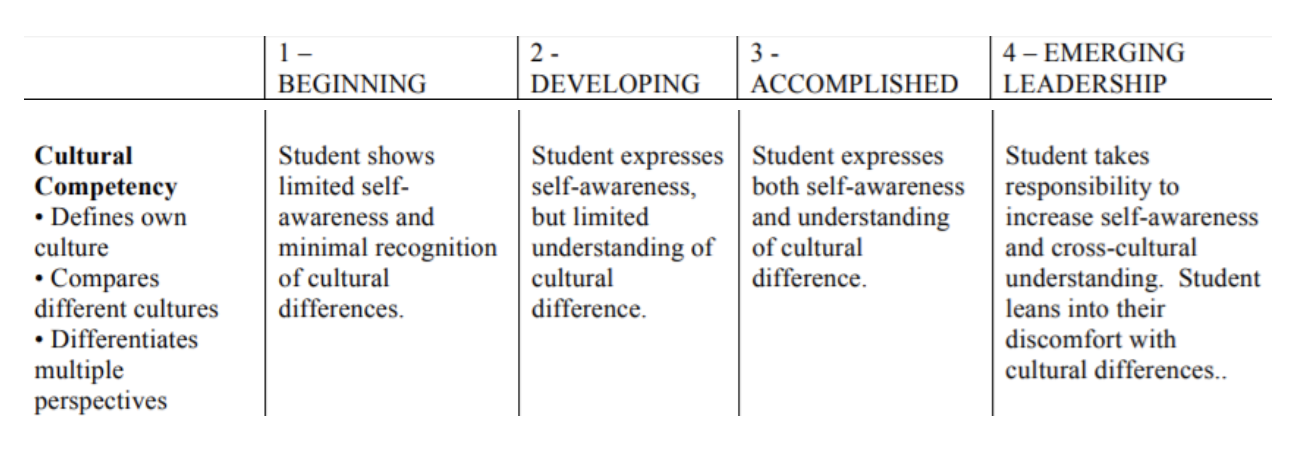
As noted at the top of the document, this rubric was developed with the “learning goals of the university” in mind, and are intended to be part of the university’s path forward in regards to community engagement.
The second is from the University of Michigan’s Ross School of Business Identity and Diversity in Organizations BBA Milestone Degree Requirement. As the following excerpt from the Identity and Diversity in Organizations BBA Milestone Degree Requirement offers:
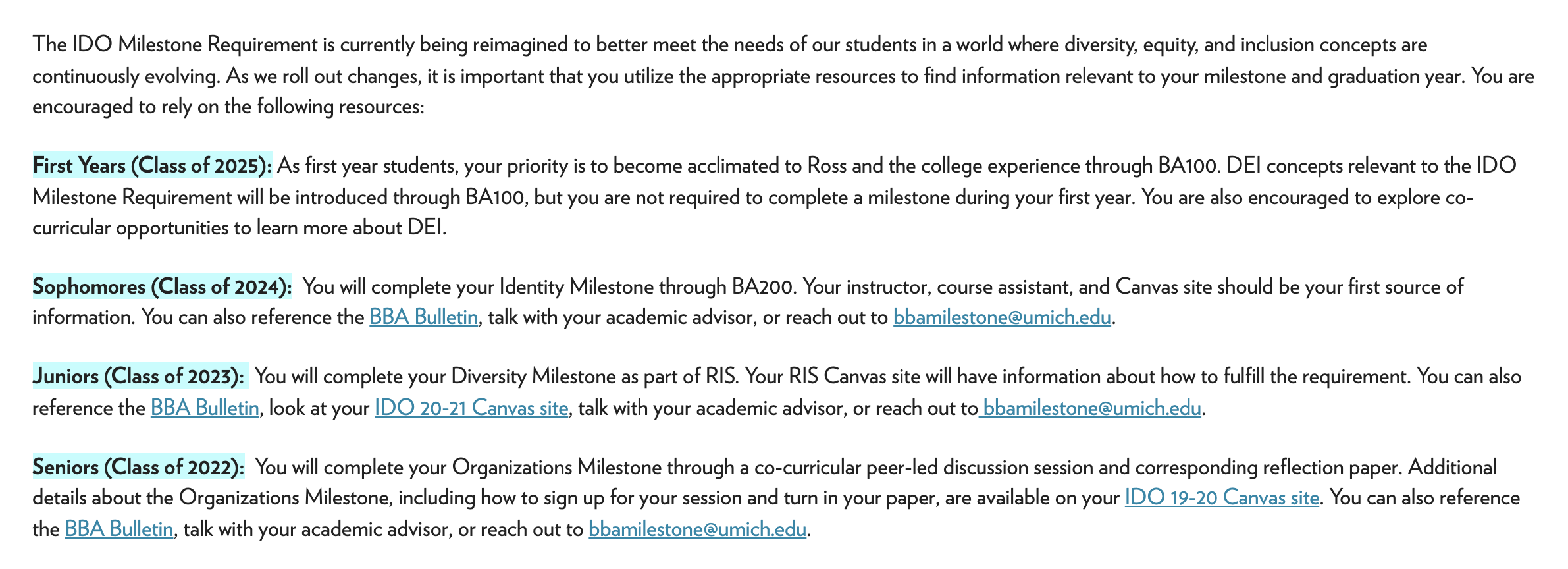
It was nice to find an example outside of Arts and Sciences, although the University of Michigan’s role as a national leader in this type of work makes such forward thinking initiatives less surprising. Still, the program specific implementation and engagement with DEI as part of a larger university vision offers a strong model, one that is also being developed in Michigan’s School of Engineering as well.
In order to develop, sustain, and maintain a community dedicated to the Diversity ILG, the team recognizes that curricular and (co)-curricular opportunities must work together, building upon and complementing each other. More importantly, such offerings must be provided to the campus as a whole—to students, faculty, and staff. The team searched institutions for online evidence of quality interconnectedness of DEI curricular and (co)-curricular programs and have highlighted two noteworthy programs: DePaul University’s BUILD Diversity Certificate Program and the University of Michigan’s numerous DEI opportunities for students, faculty, and staff.
- Certificate or Badge Program: DePaul University’s BUILD Diversity Certificate Program. DePaul’s certificate program is simple, clear, and robust with an emphasis on the development of multicultural competence and inclusion. Therefore, the BUILD program provides a good template for UD to consider when pursuing such a certificate or badge.
- Aligning (Co)-Curricular and Curricular: The University of Michigan offers a vast array of (co)-curricular and curricular opportunities for students, faculty, and staff. They have grouped their offerings in alphabetical order according to those three categories (i.e., opportunities for students, faculty, and staff). However, due to the number of offerings, the primary issue with navigating the website is that the University of Michigan does not provide a search engine to help their community members narrow the offerings to those of interest to them. Should UD adopt a similar online platform, it would help our community to have a search engine that would allow students, faculty, and staff to find opportunities of interest to them without having to scroll through the many pages of offerings.
Universities with strong accountability measures showed the most promising growth and improvement toward a sustained campus-wide commitment to diversity, social justice, equity, and inclusion. All universities with such measures included DEI work as central to their strategic plan. They provided yearly reports that included information on areas of weakness and needed improvement as well as the measures taken to address specific concerns in the previous academic year. All universities with commendable DEI work demonstrated their awareness that DEI necessitates ongoing and continuous reflection, evaluation, and movement toward strengthening their university communities. With this in mind, institutions with excellent accountability measures also provided multi-year plans.
Of the peer institutions surveyed, the four universities that demonstrated the strongest accountability measures shared a similar process outlined below.
Sample Strategic Objectives/Goals (“B” in graph below):
- make diversity more visible and celebrated
- increase retention of diverse students, staff, and faculty
- provide faculty with the tools to create and foster a diverse, equitable, and inclusive classroom increased faculty and staff attendance at diversity training workshops
Universities employed a variety of processes to strengthen accountability measures. Those include:
- Universities tasked each Department and Unit with the responsibility of determining their own strategic objectives in line with their Department/Unit mission. Therefore, the departments themselves would be required to determine their DEI goals and assessments. They then provided a report to the university committee by the end of the academic year.
- Universities provided data regarding enrollment, attrition, and retention rates of diverse students, faculty, and staff (some even from up to ten years ago).
- Universities compared their data with those of their peer institutions to help determine and justify their action items, strategic objectives, and long-term DEI goals.
- American University has a comprehensive Two-Year Action Plan for Inclusive Excellence that demonstrates strong accountability measures. For a template of the plan, see figure below.
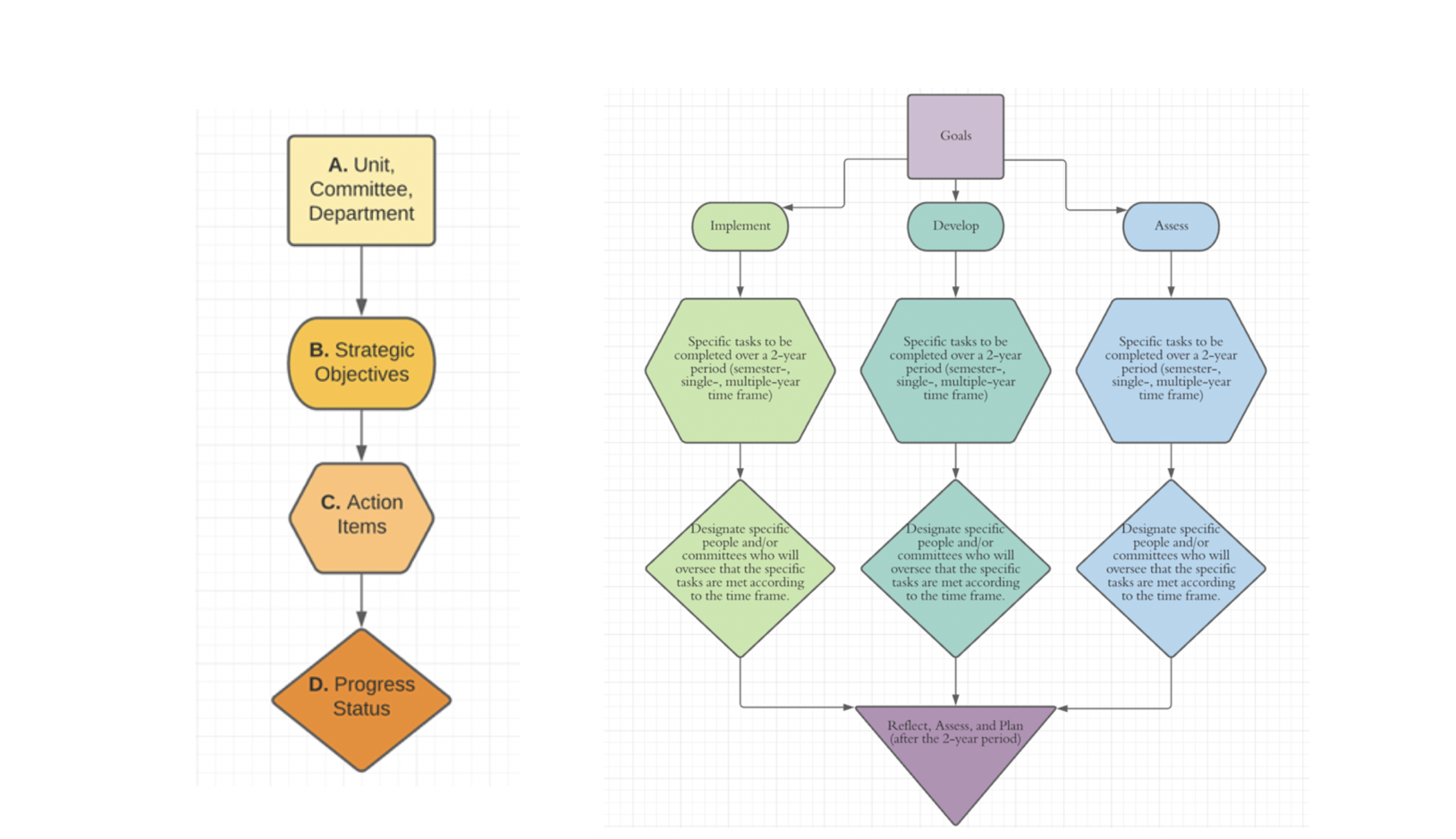
Fig. Template of AU’s Two-Year Action Plan for Inclusive Excellence
If the entire university is to be responsible for increasing our capacity to perform diversity work, accountability measures need to be incorporated broadly and widely across the university, not merely at the top levels of Administration. Similarly, those tasked with being Implementation Leads for this work (at the Department-, Program-, or Center/Institute-level) need to have Unit-level support and regular meetings to build cohesion and direction. Finally, those identified as Implementation Leads should be selected based upon their skill and knowledge of this work, not merely their good will and intention. In conjunction with accountability (Goal 3) and assessment (Goal 5), the development of a successful Diversity ILG requires ownership and engagement of the work being performed. Building upon the University of Michigan’s use of Implementation Leads at the Unit-level (see below), we should be identifying and empowering Implementation Leads within Units at the Department-, Program-, or Center/Institute-level.
For example, the work being done at the University of San Diego foregrounds accountability and easily ascertainable assessment of the work being accomplished towards their larger vision. Their Strategic Planning page not only provides yearly reports starting with the 2017-2018 school year, but also houses the USD Strategic Plan, the Strategic Funding Initiative, and the History of the Strategic Plan as part of providing a comprehensive, detailed overview of work being done at USD. The USD Strategic Plan covers the five goals, including Goal 2: Strengthening Diversity, Inclusion & Social Justice, which tracks the Key Performance Indicators (KPIs) for this goal.
They also provide an Implementation Plan for the different Strategic Initiatives connected to Goal 2:
Similarly, the Strategic Plan for Diversity, Equity, and Inclusion at the University of Michigan offers clear reporting, progress, and accountability. The Progress Reports for Years 1-4 include, for example, the Year 3 DEI Plan Details, a Tableau-based workbook where you can select a School or Unit, see their Strategic Objectives, look at the Action Items connected to each of the Strategic Objectives, as well see the colored-coded progress that is being made by that School/Unit on that particular Action Item. Under the Campuswide & Unit Plans page, you can find a copy of each Unit’s plan, as well as the name and e-mail address of the Implementation Lead for each Unit.
Finally, Ohio University’s Inclusive Excellence Strategic Plan offers a clear timeline for work being completed (see bottom of the main page), which is mirrored in the PDF of the Inclusive Excellence Strategic Plan Framework (see pages 7-8 of document) along with Implementation strategy (page 12). Similarly, as they have moved into the implementation phase of their larger plan, they have created an Inclusive Excellence Strategic Plan 2021 Action Items worksheet that makes visible the Action Items, including an Area of Focus and a Responsible Unit connected to each.
The role of assessment builds upon the work of accountability, looking to measure and make visible the ongoing work being accomplished, and/or highlight areas where intended actions and goals are not being realized. Strong assessment measures can help redirect attention to deficiencies that become visible or that have not been realized, and can be helpful in tracking progress and change over time. As will be discussed below in more detail, our own assessment work regarding CAP DSJ classes is intended to help measure where we are currently in relation to the Diversity ILG Learning Continuum in order to help identify and develop our path forward.
For example, DePaul’s Vision 2018 Final Report offers two different models of tracking this type of information. This graph tracks campus-wide diversity over a four-year period, focusing on both race and gender. It is a bit more traditional in its use of information; gains, albeit small, are made in all areas except for the percentage of undergraduate females over this period. Given that Goal 4 of DePaul’s plan was to “foster diversity and inclusion,” it would be nice to position this data better than “The share of underrepresented students of color has increased across undergraduates, graduate students and law students” (7).
The second graph below tracks six years of incoming students at DePaul against four mission-based characteristics: Pell Grant students, first generation students, underrepresented minority students, and Chicago students. Seeing the overlap across categories provides a different level of information than this graph. While it would be helpful to understand how these four mission-based characteristics were identified as part of the larger plan and/or particular goal, and see individual years disaggregated to chart progress and change over time, this graph offers information in a more compelling way than the one above.
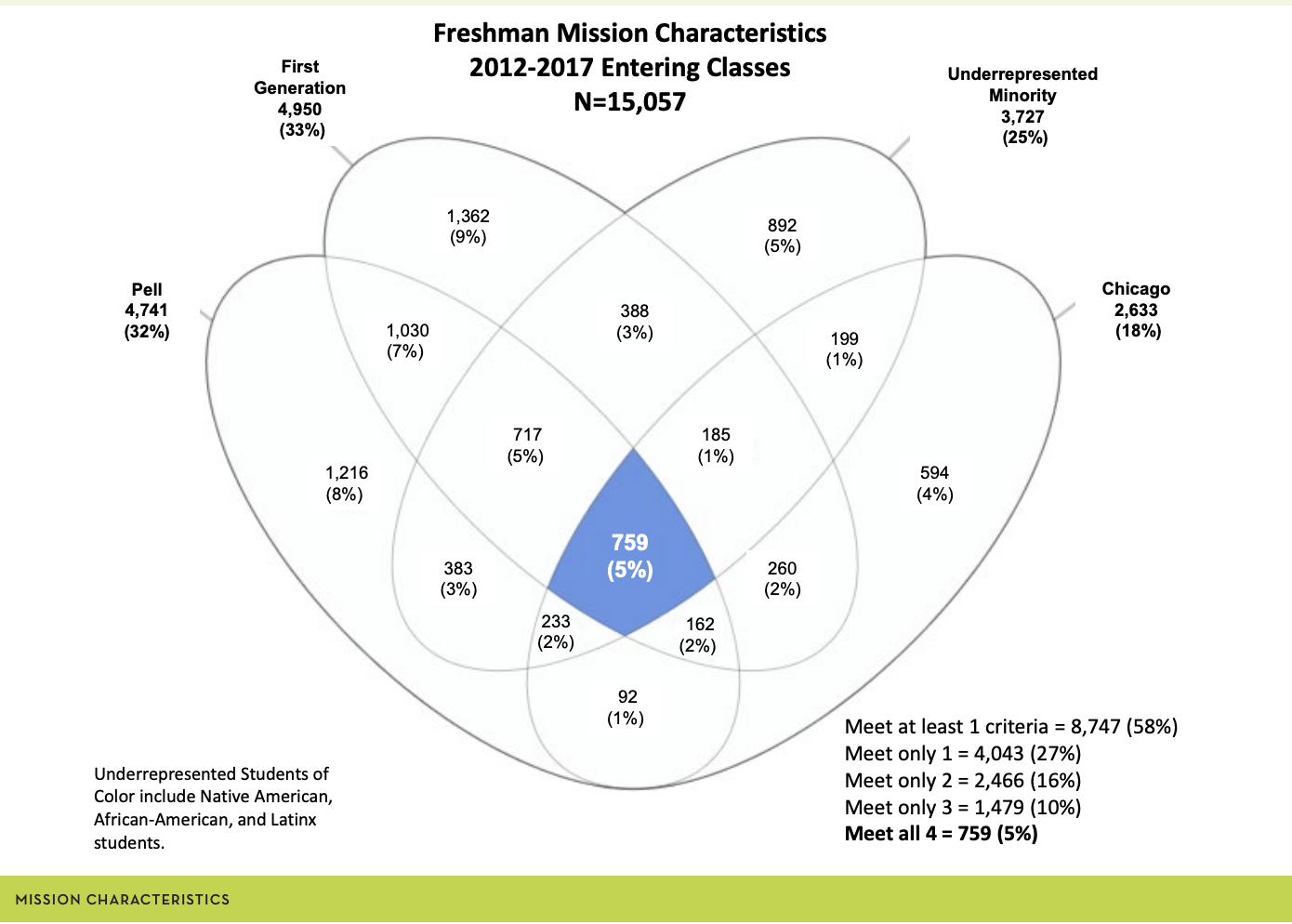 DePaul’s Vision 2018 Final Report
DePaul’s Vision 2018 Final Report
Some examples were more specifically focused, as with A Report on Efforts to Recruit, Retain, and Support Black Students at Mills College. The document maps out the origins of the document and provides historical context before developing recommendations, action items, and the subsequent assessment of those action items. While this work began in 2014, and this document was dated April 2016, one hopes that the remaining work identified continued.
Finally, Ohio University’s Diversity Dashboard, housed on the Division of Diversity and Inclusion's page, is a Tableau-based page that can be used, for example, to look at the numbers of students from underrepresented groups across five years (2017-2021), student numbers by sex and ethnicity across various units, or faculty/staff numbers for 2019-2020.
Loyola Marymount made a clear and intentional connection between diversity, equity, and inclusion and their Catholic mission. On their Diversity, Equity, and Inclusion home page, they identify and describe the Anti-Racism Project:
The Anti-Racism Project is rooted in our Catholic, Jesuit, and Marymount identity and university mission, where we regard and treat each other with respect, recognizing the inherent dignity and immutable humanity of all peoples, made in the image of God. We are called to be persons for and with others, acting out of our faith—inclusive of our varied religious traditions and worldviews—toward social justice for all.
Mills College’s Equity, Inclusion, & Social Justice page includes commitments to Gender Justice as well as to Racial Justice, including their formal admission policy for transgender and gender-questioning students, their Trans Studies Speaker Series, and their role as a Hispanic-Serving Institution (HSI). Mills’ interest in being intentionally intersectional in setting up and presenting the information on this page is worth highlighting.
-
Ongoing Education
Creating a long term and developmental university-wide education plan for faculty and staff to develop capacity.
-
Curricular Development
Developing institutional capacity for curricular change by adopting a plan to implement the Continuum.
-
Curricular & Co-Curricular
Building intentional and forward-thinking, long term connections to foster new ways of diversity-based work on campus.
Create a university-wide education plan for faculty and staff to develop our capacity to do this work. This work should be a collaboration between the Office of Diversity and Inclusion, the Learning Teaching Center, and academic units like the College of Arts and Sciences that have a higher number of faculty with knowledge and experience in these areas. This education plan needs to be long term, developmental, and ongoing, not short term or one-off, and needs to start with individual self-work and growth before applying this work to the classroom. Without individual self-work and the accompanying self-awareness, needed change regarding diversity will not happen–developing our capacity is as much about individual growth and engagement as it is about content in the classroom, and you cannot transform the classroom until you understand yourself and your intersectional identity in relation to that space. Building a yearly cohort program that is at least a semester long, but that ideally covers the entirety of the school year, will allow us to grow our internal capacity to lean into the hard work of developing our capacity to create institutional change regarding diversity.
In regards to developing our institutional capacity to implement curricular change, the Academic Policies Committee (APC) of the Senate in consultation with CAP Committee (CAPC) needs to develop a 2-3 year plan to implement the Diversity ILG Continuum. This would include adopting a timeline to make advanced-level Continuum outcomes as the requirement for CAP DSJ courses, restructuring existing courses to move CAP DSJ towards an advanced, third or fourth year CAP component as it was originally intended, developing a stronger method for reviewing courses for CAP DSJ approval (one that foregrounds knowledge of diversity work), identifying ways to continue tracking beginner and intermediate diversity work being done in conjunction with other CAP components as part of our larger mapping and institutional developmental work, and, in conjunction with the University Assessment Committee and CAPC, updating the existing Diversity rubric to better fit with current diversity work.
Building intentional and forward-thinking long term connections between curricular and (co)-curricular areas would help foster new ways to think about diversity-based work on campus. For example, (co)-curricular areas like Student Development partnering with curricular areas like the College of Arts and Sciences to strengthen and develop the Intercultural component of AVIATE. Similarly, curricular academic units like the College of Arts and Sciences collaborating with Enrollment Management to build support and engagement with Flyer Promise cohorts, as well as looking to create new ways to recruit and cohort underrepresented student populations.
The University needs to create new positions to support the growth of this work. Currently, diversity work is often just added on to already existing positions. This is the administrative version of the “add-on” curricular model that tasks people with added work on top of an already significant workload. This work is also often taken up by those who champion inclusion on campus, but for whom this work is not a formal part of their job description, or tasked to those with less hierarchical power, which can limit both the possibilities of success as well as accountability for doing the work effectively. Again, this leads to overburdening, cultural taxation, and a lack of sustainable growth for this work on campus. Creating new positions and hiring new people are key to building our overall developmental capacity. Every academic unit should have a visible high-level person that is tasked with implementing DEI work, minimally at the Assistant Dean level, but preferably at the Associate Dean level. This would create a body of people that could work in conjunction with the Office of Diversity and Inclusion to strategically implement unit-level plans and coordinate efforts across units.
Developing stronger tracking of information, and making that information readily available will help improve our overall accountability
- Track information on enrollment, retention, and graduation of students (as well as faculty and staff) from previous and current years.
- Perform exit interviews for faculty and staff, and widely share the results of those interviews to build an awareness of the experiences compelling faculty and staff to seek new employment opportunities, specifically when directly related to building an equitable and supportive campus culture.
- Make specific goals to be accomplished over multi-year periods (e.g., a University of Dayton DEI 3-Year Strategic Plan).
- In the DEI Strategic Plan, break down specific DEI objectives and goals to be accomplished over multi-year periods. Those objectives and goals will, in turn, be broken down further into specific actionable items that can be accomplished within shorter periods of time (i.e., semester-long, single-year periods). Universities with the strongest accountability measures made publicly available:
- Deadlines for the completion of action items/specific tasks. See, for example, Ohio University’s Strategic Plan, which makes publicly available actionable items that were completed during previous Fall, Spring, and Summer terms.
- Lists of specific names, committees, and/or offices tasked with the responsibility of ensuring and overseeing the completion of action items by the deadline.
- Progress updates: action items were labelled as either “completed,” “in-progress,” “beginning,” or “not started.” These labels should be updated every semester.
- Make publicly available the list of units, committees, and individuals who will be responsible for assessing the fulfillment of actionable items.
Opportunities: Growth & Improvement
Incorporating the Diversity ILG Learning Continuum into current DEI Unit Strategic Plans will provide direction and guidance for our path forward as a university, specifically as those plans move from the Unit to individual Departments, Programs, and Centers/Institutes.
The Diversity ILG Learning Continuum can provide Academic Departments, Programs, and Centers/Institutes as well as non-academic units (both student-serving and otherwise) a vision for how and where to integrate their work as a part of an already imagined scaffolded and developmental plan.
Besides providing explicit direction in identifying the skills and abilities needed to expand both the curriculum and the (co)-curriculum to meet our larger learning goals, it can inform developmental needs of other aspects of larger unit plans, like faculty and staff education.
Similarly, explicitly naming this work will also help with recruitment and retention, and will provide clear markers for assessment by identifying what we need to accomplish, both internally and externally.
With so much good will and intention around ongoing DEI efforts, the Continuum can serve as a larger unifying vision for the goals this work is trying to accomplish.
Diversity ILG Working Group
